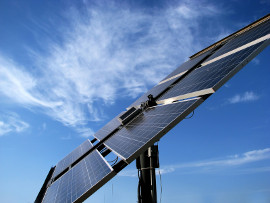Stephen Vance, Staff
 The Municipality of Meaford is moving forward with plans to turn six municipal buildings into power generating centres with the installation of solar panels.
The Municipality of Meaford is moving forward with plans to turn six municipal buildings into power generating centres with the installation of solar panels.
Five of the planned solar installations – at the Meaford Museum, the fire hall, the Harbour House, Kin Hall at Memorial Park, and the building at 390 Sykes Street which houses the OPP detachment – will fall under the net metering program, which will generate the electricity needed to power each of those buildings, saving the municipality thousands of dollars in hydro costs.
The sixth solar installation will fall under the provincial feed-in-tariff program (FIT) that will generate revenue for the municipality. The 100 kW solar installation is destined for the public works building on the 7th Line.
“Meaford is in an excellent position to benefit from solar with a fairly large number of feasible sites and a mix of investment opportunities: FIT, MicroFIT (MF), and net metering (NM),” Meaford Treasurer Darcy Chapman told council in a report presented at their September 12 meeting. The latter shows the best rates of return, particularly now as the 10 percent Ontario Clean Energy Benefit bill reduction was eliminated this year and the province has seen two electricity rate increases in the past eight months. The price of power will likely never decrease, especially considering the fact that despite numerous corporate and citizen complaints, Ontario still has reasonable rates. Our peak time-of-use rate is now $0.18. It is as high as $0.45 in parts of Southern California.”
Chapman told council that in addition to the financial benefits that will be realized by the municipality, solar power generation is environmentally friendly, and the municipality hopes to lead by example with the project.
“They are also going to be, hopefully, a catalyst for other people looking at this from a personal perspective at their own residence,” suggested Chapman, noting that the ripple effect is already taking place. “Because of the work that we have been doing, the Anglican church has put in an application and has received approval to put an installation there. The Curling Club is looking at it, and there are other public institutions that are looking at it as well.”
The expected cost of the 100 kW installation on the 7th Line is nearly $290,000, and each of the five net-metering installations will cost roughly $33,000, for a total investment of just over $450,000, which will be funded by debt that would be paid back by either the energy saved, or revenue generated.
While Meaford will borrow the money to fund the installations – either through traditional loans, or by borrowing from municipal reserves (Meaford currently has more than $6 million in municipal reserve accounts), Chapman told council that solar installations are a good use of debt.
“In the instance of solar, it’s an excellent use of debt, because you’re going to use debt in order to generate revenue. Using debt to generate this revenue is absolutely an effective use of debt,” Chapman told council.
The 100 kW installation on the 7th Line is expected to generate more than $33,000 per year, with a net annual income of roughly $11,000 after debt repayment, insurance, and maintenance costs, meaning that the installation could generate more than $220,000 in net revenue over the course of the 20 year FIT contract.
The five net-metering installations are expected to offset between $2,675 and $3,075 in electricity expenses, which would ultimately save $500 to $900 per year after debt repayment costs, meaning the project could result in savings of $16,500 to $29,750 per installation over a 20 year period.
Chapman also told council that the municipality wouldn’t necessarily need to borrow money from traditional lenders, they could also borrow from themselves.
“We have the opportunity with solar as well to not to have to even use debt. We can use our existing reserves and reserve funds almost as if it was an investment on the municipality’s part over the next 20 years. Use some of that money to pay for the cost of the solar, and then every year pay back one twentieth of that plus the interest just like we would if we had entered into an agreement with Infrastructure Ontario,” Chapman advised council.
Though Meaford could use reserve funds instead of traditional debt, Chapman cautioned that such a plan would rely on future councils honouring the reserve repayment plan, making traditional borrowing perhaps more appealing.
“If you’re going to go with self-financing, you’re now saying that every council thereafter has to worry about that self-financing aspect. Whereas a loan is set in stone. This council can say with the utmost certainty that you’re going to pay that money back into reserves. But five years from now, another council is in place, and they have some tough decisions to make about an infrastructure project maybe, and instead of paying that money back into the reserve fund, they use it to offset a tax increase in that year, and now the money is gone, and may not be replaced in the future,” suggested Chapman.
Staff will prepare a report outlining the funding options, to be presented at a future meeting. Installation of the solar panels could begin as early as the Spring of 2017.











